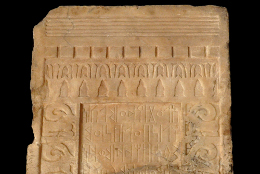
Corpus of Central Minaic Inscriptions
The corpus of the Central Minaic inscriptions includes about 1,300 texts coming from Jawf, the northernmost South Arabian region. This corpus has been largely increased in the last years thanks to the edition of recent archaeological findings and of many interesting texts of the National Museum of Ṣanʿāʾ.
Inscriptions in Minaic are attested during the 1st millennium BC, at least from the beginning of the 8th century until the last centuries of the millennium/beginning of the Christian Era. The majority of the inscriptions preserved from the early “Madhabaean” period (here under the label of “period A”) are dedicatory texts, in which objects or people are consecrated to the gods; construction texts of temples and palaces are commissioned by the kings. The texts are a precious source on the history of the Jawf, which territory was divided among Sabaʾ and the city-states of Ns²n (as-Sawdāʾ), Kmnhw (Kamna), Hrmm (Haram) and Qrnw (Maʿīn) that left documentation in what we call “Minaic” language.
Ns²n shows to have been the centre of the interactions among the political powers of the Jawf during this period: its intra muros sanctuary of the 8th century commemorates the representative gods of the main city-states of the Jawf and of the Sabaean kingdom, with their figures engraved on its pillars. This is the only certain case of divine representation in South Arabia. This artistically flourishing period has left its main attestations in beautiful objects like offering tables with gutter in shape of bull's head, decorated slabs, altars and thrones; the most peculiar stylistic Madhabaean feature is surely represented by the so-called decoration "of the Banāt ʿAd", a representation thick with natural elements and feminine divine figures incised on the pillars of some temples (e.g. as-Sawdāʾ's extra muros sanctuary of ʿṯtr ḏ-Rṣf).
Period B starts with the unification of the Jawf by Maʿīn, whose expansion probably began in the late 7th century and was accomplished by the mid of the millennium. The Minaean kingdom imposed its royalty, pantheon and institutions on the previous city-states of the region, although some sporadic hints to the survival of local kingdoms in some periods have been found. A shift in the writing style is perceptible, not only in the graphic features but especially in the style and formulary of every textual typology. Dedications almost exclusively concern construction works commissioned by private citizens, magistrates or kings on the city gates (in Maʿīn) and walls (the immense documentation from Baraqish), combining the two most common textual typologies. In the body of the text, sometimes specific events are commemorated: in M 247 the account of a commercial expedition abroad gives us one of the few external synchronisms that bind South-Arabian history to an absolute chronology. Legal and penitential texts are more common than in the previous period.
The beginning of the Christian era has been recently proposed as the turning point for the disappearance of the kingdom of Maʿīn. However, this chronology is still under debate and the previously accepted dating of the 2nd/1st century BC is still a valid hypothesis.
Almost half of the Minaic documentation is constituted by the so-called "stelae with eyes", small funerary monuments with the name of the defunct and the sketch of eyes or human face. The majority of them come from illegal excavations in the Jawf, but some were found during the Italian excavations of the necropolis of Baraqish, proving that they can be considered Minaic texts.
Period B starts with the unification of the Jawf by Maʿīn, whose expansion probably began in the late 7th century and was accomplished by the mid of the millennium. The Minaean kingdom imposed its royalty, pantheon and institutions on the previous city-states of the region, although some sporadic hints to the survival of local kingdoms in some periods have been found. A shift in the writing style is perceptible, not only in the graphic features but especially in the style and formulary of every textual typology. Dedications almost exclusively concern construction works commissioned by private citizens, magistrates or kings on the city gates (in Maʿīn) and walls (the immense documentation from Baraqish), combining the two most common textual typologies. In the body of the text, sometimes specific events are commemorated: in M 247 the account of a commercial expedition abroad gives us one of the few external synchronisms that bind South-Arabian history to an absolute chronology. Legal and penitential texts are more common than in the previous period.
The beginning of the Christian era has been recently proposed as the turning point for the disappearance of the kingdom of Maʿīn. However, this chronology is still under debate and the previously accepted dating of the 2nd/1st century BC is still a valid hypothesis.
Almost half of the Minaic documentation is constituted by the so-called "stelae with eyes", small funerary monuments with the name of the defunct and the sketch of eyes or human face. The majority of them come from illegal excavations in the Jawf, but some were found during the Italian excavations of the necropolis of Baraqish, proving that they can be considered Minaic texts.